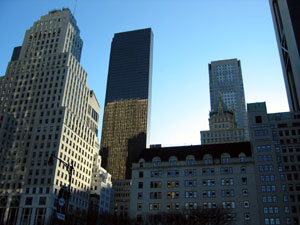Page 1 Page 2 Page 3 Page 4 Page 5

Calderon Bag and Belts was located at 443 Greenwich Street, an isolated armpit of a neighborhood cut off from the rest of downtown Manhattan by the entrance to the Holland Tunnel on the east and the heavily industrial Canal Street to the north. It is now an exclusive part of Tribeca, though back in 1982 you didn’t see any international heiresses pushing Italian-engineered baby prams. It was more like rejects from Ward’s Island or Creedmoor pushing supermarket shopping carts. Basically, nobody walked the streets, which were lined with shuttered warehouses and industrial installations. It was desolate even by New York standards, which was pretty bare.
Given the fact that the murder rate in New York at that time was astronomical, running on the order of 3,000 deaths a year, you had to step lively lest some deranged nut job jump out from a doorway or from between parked cars and pop a cap in your face. After a few years of living here, I grew calloused to that reality, but at the time this account takes place, I don’t mind admitting to the reader that I was still a little tender, and I wasn’t the only one. Tougher men than me were apprehensive at the prospect of getting blown away, which explains the celebrity of subway vigilante Bernhard Goetz, or the popularity of the Charles Bronson Death Wish movies at that time. As one of the leather cutters at Calderon, a very large guy named Walter Dooley, lamented to me: “It don’t help to be tough. If the guy thinks you’re too tough for him to handle, he’ll just start shooting even before he even robs you.”
Nevertheless, you had to go to work, and I showed up at the Calderon factory at the appointed hour for my first day at work and crowded through the front door with the factory help, who were rushing to be at their places before the bell rang to start work.
Bill Daniels, the factory manager, took me to the same empty room where, the day before, I had designed the belt that had landed me the job. All the tools he had issued me — my knife, scissors, ruler and pattern-making curve — were still on the work table where I had left them. He told me: “We have to keep you in this room for now until we convince the designer you are going to work under to consent to train you. And that might be a hard thing to do.”
Obviously, it is a rare man who is willing to train his eventual replacement. The guy might refuse to train anybody. He might put his foot down and become obstinate like a mule. Hell, I don’t blame him. Maybe if more people had resisted and refused to train their replacements, there might still be some good industrial jobs left in this country today. Certainly, the guy would have had a lot of leverage. The fact that they didn’t just inflict me on him without first consulting him spoke volumes about his importance to the company.
Of course, the boss also has some leverage. He’ll start off by assuring the guy that the new man is no threat to his job. He’ll remind him that, with the heavy workload that’s anticipated, the new assistant will be there to make his life easier. After all, he’s not getting any younger. And what’s he going to do — leave the company in the lurch when he does eventually decide to retire?
And, of course, the company will offer him a raise if he goes along with the program, which will be the clincher, naturally. And with that they will have him. Once he accepts the money, he’s locked in. But first, it’s better if he doesn’t physically see his replacement, if the assistant is an abstract rather than a physical reality.
In the meantime, I was to remain isolated, quarantined. To keep me occupied, Bill Daniels instructed me to work on a pattern for a 2” contour belt, which must have been the first thing that popped into his mind, because with all the belt patterns and cutting dies in the 5-story factory, another 2” contour belt pattern was the last thing they needed. The idea was to keep me hidden and quiet pending negotiations with the designer, who was named Louie Janz.
Not that I was completely incommunicado. As the morning wore on and I fudged around with the pattern paper and the knife, the pencils and pins, I had a steady stream of visitors, initiates who had been let in on the big secret — Louie’s new assistant — and who wanted to have a look at me.

